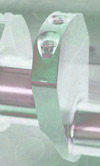Crankshaft Steels
 As was mentioned in the previous RET Monitor article on crankshafts, it is our belief that nitriding steels are the most commonly, if not exclusively used materials. This month we take a closer look at nitriding steels for crankshaft manufacture, expand a little more on the importance of the ‘cleanliness’ of these types of steel and touch briefly on the benefits of nitriding.
As was mentioned in the previous RET Monitor article on crankshafts, it is our belief that nitriding steels are the most commonly, if not exclusively used materials. This month we take a closer look at nitriding steels for crankshaft manufacture, expand a little more on the importance of the ‘cleanliness’ of these types of steel and touch briefly on the benefits of nitriding.
The bar-stock used to make an Formula One crankshaft is not necessarily much different from that used in other formulae; indeed some manufacturers in ALMS / LMES use the same basic composition of steel. As was also mentioned last month, there are several different grades to choose from for a given composition, depending on the 'cleanliness' of the material. By cleanliness, people often mean the percentage of sulphur and phosphorous in the material. Sulphur is commonly added to basic engineering steels in order to improve machinability. However, it can lead to problems by combining with metallic elements to produce large inclusions of sulphides in the ingot. These can then, by the process of rolling form long axial defects (also called ‘stringers’) in the material and this is one of the reasons why engine manufacturers steer clear of the basic 'EN' grades of steel in the UK. If you look at the composition of steels, it is common to see the percentage of sulphur and phosphorous quoted for engineering grades, and often a combined figure for the two.
If we look at the percentage of these two important elements in a steel composition commonly used for racing crankshafts in engineering and aerospace grades, we can see the difference in the quantities of these important elements.

Table 1: Composition of engineering and aerospace grades of a crankshaft steel. Maximum Sulphur and Phosphorous contents shown in bold.
As can be seen, the basic compositions of the steels are very similar, and 3S132 also conforms to the composition for EN40C.
Steel manufacturers quote these figures because of their well-known effect on the dynamic mechanical properties of the material. They have very little effect on other qualities of the steel such as hardenability or corrosion resistance for example.
This drive for cleanliness in the steel not only means that we are likely to see less gross axial inclusions (also called 'stringers'), but that we also get a very useful increase in fatigue strength. One European steel manufacturer presents data for nitrided steel which shows over 30 percent improvement between the basic and double-remelted grades of steel at 107 cycles. This remarkable figure means that a design engineer, armed with such data, can design to very much higher allowable stresses, or that he has the comfort of a higher safety factor against fatigue failure.
The main effect on fatigue life is the effect of the nitriding treatment itself. This surface hardening treatment not only produces a very hard, wear-resistant surface, it imparts a high level of compressive stress on the crankshaft. This compressive stress greatly increases the fatigue strength of the component, and is especially effective where stress concentrations are concerned. For the crankshaft designer the main stress concentrations are oil holes and fillet radii. References to the benefits of nitriding with regard to fatigue can be found in metal fatigue textbooks published over a number of decades. We shall look further into the available nitriding processes in a later article and the various solutions which people use for their racing crankshafts.
Written by Wayne Ward.